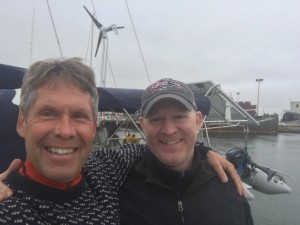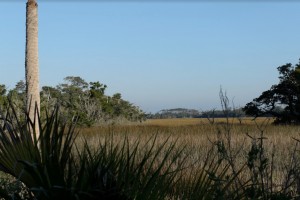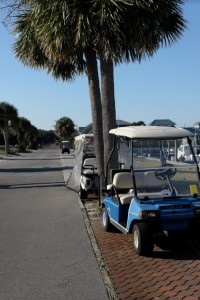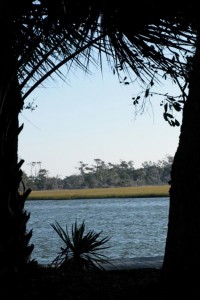There was never a night or a problem that could defeat sunrise or hope. (Bernard Williams)
My brother, Jon, and I had a wild and wooly 250 mile sail from Norfolk, Virginia to Moorhead City, North Carolina on a forty hour – 25 to 35 knot Northeast blow – surfing 8 to 9 foot waves and hitting 12 knots over ground. It was better than any ride at Busch Gardens. During the
first 24 hours, we sailed over 160 nautical miles and averaged approximately 7 knots per hour. Not too shabby for a boat built more like a
Sherman Tank than an Italian Ferrari. We paid a price for our good wind fortune, however, as we were a bit green around the gills for most of the trek.
Jon is a Navy Mustang, a term of respect given to an enlisted sailor who later becomes an officer. He has overcome life adversity, has a compellingly positive outlook on life, and is an outstanding father, husband, brother, and Naval Officer. And it has been one of my life pleasures to share adventures with him over the years… Below is Jon’s description of our latest foray:
“On our way out of Portsmouth, we passed by many of our U.S. Navy East Coast fleet: Frigates, Destroyers, Amphibious Docking Ships, and Carriers. One of the carriers docked that day was the Harry S. Truman (CVN-75) for which I had the privilege to serve on as a Medical Administration Officer from 2014 to 2016. I felt it was a good omen for our trip knowing that the Truman always got its sailors back safe from its many deployments.
We headed past Fort Story and past Virginia Beach and finally to the notorious North Carolina Outer Banks. That’s right about the time I started to get seasick. The swells seemed to get larger with every nautical mile we went. Once again using my inside voice : “Sure, Dave said join him on a sailing trip, it will be fun,” as I’m spending more time hunched over the side rail than enjoying the wind and sea air. But in all seriousness, I pushed through my bouts of seasickness because in the end what is an adventure without a little discomfort (OBL: “Oakes’ Brothers Logic”).
We met some rough conditions getting past the Outer Banks. It was truly a sailing experience with the wind and the waves slapping our 35 foot boat – Tusen Takk. I was very proud of my brother watching his seamanship, navigating the conditions, adjusting sails, and altering course as needed throughout that portion of the trip. I was there for support, but knew it takes a team and a level head to get through these conditions. We pushed through our 2 hour shifts. And right when we thought it was going to get a little easier we passed the southern corner of the Outer Banks and headed north toward Shackleford Banks, but directly into the wind. Needless to say, we had a long night ahead of us. We discontinued our 2-hour shifts and stayed up together to manage the navigation and sails. This leg of the trip should have taken us 3 hours in ideal conditions but lasted 8 hours. We managed to get into Morehead City on 11 November at 23:30. After docking Tusen Takk, tired and exhausted – the bunk looked the best it ever had.
Much like my recent sailing experience with my brother, Dave, sustainability is a team effort and can only be achieved with team work at all levels and most importantly reaching solutions with level heads and clear minds.”
Note: Jonathan served as a Fleet Marine Force Navy Corpsman for 9 years and is an Iraq War Veteran. He is currently a Lieutenant in the U.S. Navy’s Medical Service Corps and works as a Health Care Administrator. He has a B.S. Degree in Health Care Administration and an M.S. in Health Care Management. He currently lives in Chesapeake, VA with his wife and two daughters.
Jon took a bus and train combo back to Norfolk from Moorhead City, and I continued sailing solo to Cape Fear and Bald Head Island – a 115 mile through-the-night trek with 20 knot Northwest winds and 4 foot following seas. What might previously have seemed like strong winds, now seemed remarkably more benign after our Outer Banks adventure. I then sailed on to Little River, NC, Winyah Bay, SC and then to Charleston where we will be leading a series of Climate Action Now (CAN) programs at public schools, the Charleston Public Library, and the College of Charleston.
As mentioned in previous blogs, the purpose of the CAN program is to inspire people to take action to reduce carbon and other forms of pollution. And a key piece of this work is inspiring people with a sense of hope that then empowers self-agency. Below is a synopsis of an article by Damian Carrington entitled “Seven Mega Trends That Could Beat Climate” that provide a real-time picture of hope.
We all know that we’re facing some big problems, and there is a lot of bad news out there highlighting them. But what about the good news? What about the solutions? Bad news stifles action; good news spurs it. Here are seven reasons to be hopeful – solutions that demonstrate that progress is growing exponentially:
- Methane: getting to the meat: Carbon dioxide is the poster child for climate change. But methane and nitrous oxide are more potent than C02. And the major source of methane is livestock farming – belching cattle and manure. Cool solution: raise more plant-based meat which has a tiny environmental footprint. It’s catching on and funders like Bill Gates and former Google CEO Eric Schmidt believe that plant-based foods can make a significant dent in tackling climate change. And major meat and dairy companies are investing in plant-based products which are environmentally friendly, healthier, and avoid animal welfare concerns. Plant-based milks like soya, almond, and oat already command 10% of the market. Billionaire entrepreneur Richard Branson says: “I believe in 30 years or so we will no longer need to kill any animals and that all meat will either be (lab) or plant-based, taste the same and also be much healthier for everyone.”
- Renewable energy: time to shine: Production costs for wind and solar have plummeted by 90% over the past decade. In many parts of the world, renewables are the cheapest electricity available. They are here to stay! The train has left the station. Did you know that solar energy has been used for over 2700 years. In 700 BC, Leonardo Da Vinci predicted that there would be a solar industrialization. I guess he was right…
- King coal: dead or dying: The opposite side of the renewable boom is the death spiral of coal, the dirtiest of all fossil fuels. Peak coal production was in 2013 and is declining substantially. The key reason? Solar and wind are cheaper. China has mothballed 151 coal plants and is expanding its renewable energy, in the U.S. coal plants are closing at record numbers, and in the UK coal use has fallen from 40% to 2%. The coal train is leaving the station, but without coal.
- Electric cars: in the fast lane: Again, China is out in front – selling as many electric cars every month as Europe and the US
combined. Tesla is unveiling its more economical Model 3 and all major global carmakers have committed to an electric future, with
Volvo and Jaguar Land Rover stating that they will end the production of pure fossil-fueled cars within three years. The picture to the right was taken on Bald Head Island in North Carolina – a small community where people dart around in a wide-variety of electric golf carts. I had to wonder: “What if they were all powered from renewable energy?” It’s coming…
- Batteries: lots in store: Storage of electricity via batteries is key to enabling renewable energy to reach full potential. The megatrend of lithium-ion batteries has dropped prices 75% while efficiency and storage capacity are increasing. Long-distance electricity interconnectors are being built to enable the storage of energy for longer periods.
- Efficiency: negawatts over megawatts: If green energy is the poster child for sustainability, energy efficiency is the quiet, but equally brilliant sibling. Through better design, we are building everything from homes to gadgets and appliances that require substantially less energy to operate. Less energy to operate, less carbon pollution, better return on investment. Hey, what’s not to love here? Energy efficiency has improved in EU homes, transport and industry and we’re making progress here in the U.S. as well.
- Forests: Seeing the wood: Cutting of global forests for ranching farming, and lumber accounts for about 10% of greenhouse emissions. Annual tree losses have doubled since 2000. This is the only megatrend not pointing in the right direction. Stopping tree loss and planting new trees is one of the cheapest and fastest ways to cut carbon emissions. Climate policy, however, massively underfunds forests which receive only about 2% of global climate finance. New research has shown that better land management could deliver a third of all the carbon cuts the world needs.
These hope-filled mega-trends are not only good news, they represent exciting state of the art solutions to our climate crisis. And for the most part, they aren’t driven by governments, but rather by innovators, entrepreneurs, and business leaders. We all have a role to play in championing creative solutions. People want to hear good news. It isn’t political, it’s simply, well, sensible. And it can build bridges between the partisan ideology trying to divide us.
Bernard Williams said: “There was never a night or a problem that could defeat sunrise or hope.” As the above mega-trends indicate, there is much to be hopeful about. There are exciting innovations, technologies and markets for sustainable products and ideas opening up around the world. And when we speak up for what is morally right – letting our actions flow from our truth (from the values we hold and cherish and the fertile moral ground from which they grow), we help promote and define the type of world we want for our children and grandchildren.
Stay tuned: Our next blog is a special issue focusing on “A Season of Gratitude.”
To subscribe to (or unsubscribe from) these blog posts, write to jonathan@cellonline.org.
*CELL is currently accepting applications for college sustainability focused study abroad programs, to Iceland, Central America, Ecuador, and Scotland. Faculty may contact CELL regarding custom programs for your college. Go to cellonline.org for more information and to apply.”




